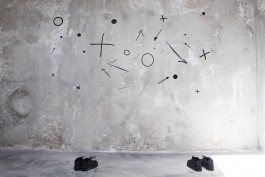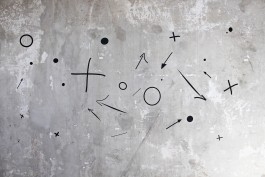











Walking Lines
20.08.2020
Artist: Tomas Spicer
The work in this show is centred around a text that responds to ideas about Porto, but also cities and civilisations in general. We spend a lot of time walking around and looking at things. Certain things have a way of jumping out at us, and making their way into our consciousness. After being in a place for a long time, things seem to disappear or fade away into the background. Things that at first stood out as extraordinary become totally invisible. Walking Lines is about trying to hold on to these things and make them visible, or to press pause on an idea as it fades.
It’s interesting to think about why we notice some things and don’t notice others. The use of the gallery as a space to present ideas in is useful, as it’s a space that supports a sort of hyper awareness, because galleries have a way of making people observant. When we leave the gallery and go out into the street this awareness diminishes, or becomes different, so we don’t see or look in the same way. The exhibition acts like the internal spaces of mind, or like a purgatory of ideas, or maybe like a waiting room for thoughts, and as a place where these thoughts can be looked at and seen.
The main component of the show is a text based work that has been broken down into three parts. These individual parts have been installed into public spaces in and around the city and are viewed in isolation, so they are kind of fragmented. The only place where these texts come together in is the exhibition itself. Each text individually responds to different ideas about the city.
Artist Statement:
Tomas Spicer, (Islington, London, 1988), currently lives and works in Surrey. Tomas holds a BA (Hons) in Fine Art from Central Saint Martins, University of the Arts London and a PGCE in post-compulsory education from University College London. Tomas makes artworks that materialise in many different forms ranging from painting to text, sculpture, performance and publications. His abiding interest is the process of ideational transmission, and the difficulties – of both articulation and interpretation – that hinder effective or faithful communication. In particular, his work explores why and in what ways artistic expression – painting, sculpture, language, action – can only imperfectly convey ideas from mind to mind; from artist to viewer, reader or observer. His preparatory work is largely discursive – playing with, and stretching, ideas in conversation with others, and testing the limits of accurate and comprehensive communication. The pieces that emerge from these discussions are often bold and minimalist – a demonstration of, and response to, the difficulties of transmission. Yet it is the process as a whole – the preparatory discussions and their subsequent objectification, and the uneasy relationship between the two – that mark the focus of his work. Part of a contemporary oral tradition, his process and work reflect a deep interest in the consistency and stability of meaning.
Photos: Tomas Spicer, @bliverartist